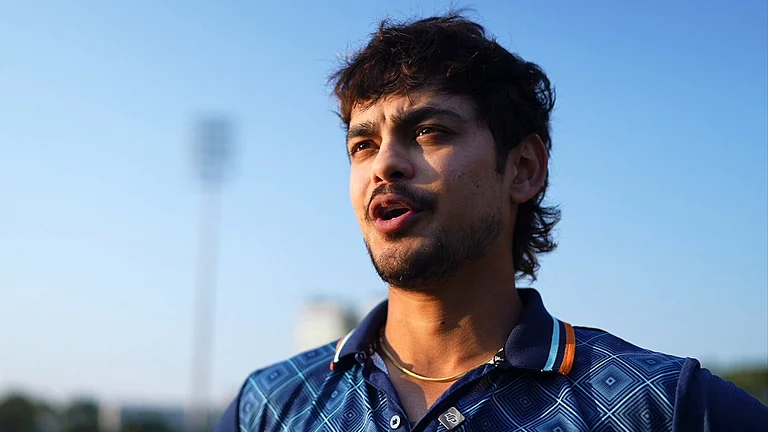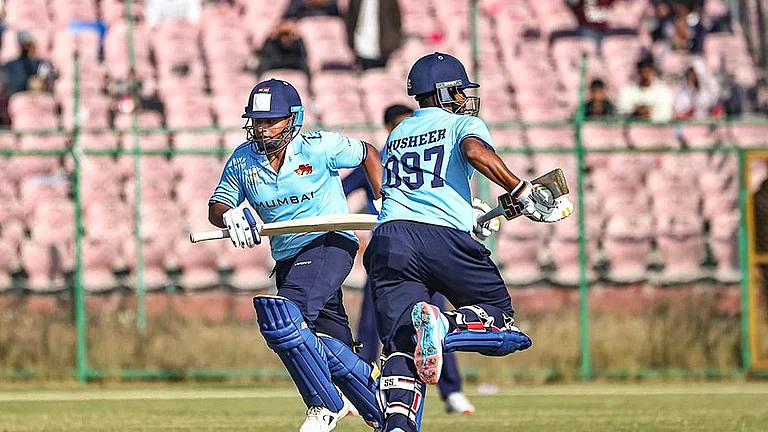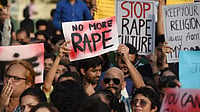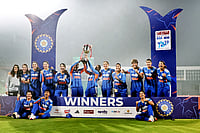The invitation gained us brothers entry into the house of the first family of India. We became close to Indira Gandhi and then her father Jawaharlal. Indira began to invite us to the house regularly. She wanted me to get to know what her father was really like as a human being before I started to put his likeness on canvas. She had done the same when Epstein wanted to sculpt him. In the course of trying to (get to know him) we got to know Indira better than we got to know her father. The two had very little in common. He was an extrovert, full of zest and spirit. She had inherited more of her mother's traits and was withdrawn and melancholic. This sadness could be discerned in her face as well as in photographs of her mother.
An oppressive sadness dominated most of the paintings I was creating those days. Naturally I was strongly drawn towards Indira and more keen to paint her than I was to do her father's portrait. I confessed this to her. She was flattered and agreed to sit for me. So I painted Indira Gandhi's portrait before Jawaharlal Nehru's.
Since Inder always accompanied me to these sessions, he got to know Indira quite well. They were about the same age and shared the same interest in India's political history. It is ironic that the very portrait that brought us three together was to be the reason for her cutting me out of her life in later years.
A few days after I finished Indira's portrait, Fabri, who knew her well, suggested we arrange an evening at our house and invite a select group of artists, art-lovers and critics to see the portrait. The evening was a great success. Indira graced our little home and amused everyone by telling them of people's reactions to the painting while I was still at work on it. The one person she avoided mentioning was her husband Feroze Gandhi. He had interrupted one of the sittings and given me a withering look that clearly indicated his contempt for my efforts. I was not wrong in my surmise. Inder Malhotra, the journalist who was a close friend of Feroze, later told me that Feroze was surprised to find me wasting my time and talent painting a woman who had nothing to distinguish her except the fact of her being the daughter of the Prime Minister. He had quoted Professor Harold Laski, whose classes both Feroze and Indira had attended in England, as saying 'She is a stupid girl with not a single idea in her head.'
I have vivid recollections of sudden changes of expression on Indira's face during every sitting. I had to track and capture her moods each day she sat for me. In the process her dominant and characteristic look eluded me. Nor did I try to fix it in the final version. This was because I lose interest in my own painting as soon as I have put the final stroke on the canvas.
Let me try to explain this better. The closest analogy that comes to my mind is having sex with someone. As long as the act lasts, one is totally absorbed in the partner; as soon as it is over, one feels detached and distant from the very person on whom a minute ago one had expended so much passion. That being so, Fabri's review in the Statesman the next morning came as a bit of a shock. While he applauded my craftsmanship, he felt I had failed to portray the essence of Indira Gandhi. According to Fabri,I had depicted her as someone cold-blooded and ruthless, which Fabri was sure she was not. My portrayal of the future Prime Minister of India played an important role in determining the later relationship between the Gujral brothers and the Nehru-Gandhi family.
I put the portrait away instead of delivering it to the Prime Minister's house. I kept wondering why I had given Indira Gandhi that particularly compelling and disturbing expression. Had I unconsciously depicted the moment her husband Feroze had violently entered the room? We came to the conclusion that perhaps behind the facade of smiling gentility was an embittered woman concealing vengeful and arrogant traits.
A Tenuous Brotherhood
While Inder Gujral embarked on his political career under Indira, it was a painful learning ground in the cut-throat world of realpolitik
Apart from Krishan Kant, the other luminary of Indian politics I would like to mention with pride and love is my brother Inder, who became Prime Minister of India in 1997. His journey to the Prime Ministership could be said to have begun when he became close to Indira Gandhi after the death of her father Jawaharlal
Nehru. This was partly due to the fact that when other ambitious politicians began to desert her and switch their loyalties to Prime Minister Lal Bahadur Shastri, Inder stood by her. She sensed he was a man she could trust. When her father's body was being bathed prior to its cremation, she asked Inder to stand guard and prevent intruders from entering the room.
Indira Gandhi knew that Inder's father and Lal Bahadur Shastri had been close friends, admirers of Lala Lajpat Rai and active members of his Servants of the People Society. Inder had not transferred his affiliation to Shastri's camp. He chose to stay with Indira, though the surest way of being blacklisted by Shastri's supporters was to be seen in the company of Indira Gandhi.
Shastriji had of course included Indira Gandhi in his cabinet as minister of information and broadcasting. But this, according to a local wit, was reminiscent of an American president who had explained why he had inducted an opponent of his government into his council: 'I would rather like the bastard to be inside the tent and piss out, than to stay out and piss in.' Indira Gandhi was well aware of this. She felt claustrophobic under the tension of working for a Prime Minister who wanted to keep his eye constantly on her lest she became too popular. At one time she seriously contemplated resigning and taking to art. On one of her visits to our house she consulted me about the aspects of painting as a vocation. The fact that she did not quit the cabinet was due to the persuasion of three friends in whom she confided: Dinesh Singh, Inder and Romesh Thapar. How long she could have remained part of the Shastri regime is difficult to gauge. Then came the news of Shastri's sudden death at Tashkent in the early hours of 11 January 1966.
Immediately after the shocking news was broadcast, Indira Gandhi rang up Inder, Romesh Thapar and Dinesh Singh and invited them over for breakfast next morning. Before the three went to her home, they spoke to each other on the phone and agreed that they should persuade her to contest the succession. By then it was common knowledge that several other contenders were working overtime to canvass support for themselves.
Indira Gandhi told her confidants that Gulzari Lal Nanda, who had acted as caretaker prime minister after the death of her father, had already approached her for support in his bid for succession. She had avoided committing herself and changed the course of the conversation to harmless subjects. She tried the same tactics now with her three friends. She began by seeking their advice on domestic problems, such as her kitchen expenses.She launched into a long tirade against the ever-increasing prices of consumer items. The focus of her lengthy harangue was the wife of K.D. Malaviya who had been petroleum minister in Nehru's cabinet. Mrs Malaviya had a poultry farm from where Indira Gandhi got her supply of eggs. She was furious about Mrs Malaviya's exorbitant rates. Mrs Gandhi's three guests were flabbergasted. The future of the nation was at stake, and their hostess was wasting time talking about eggs! Surely the Prime Ministership of the world's largest democracy with one-fourth of the world's population was more important than the prices of poultry items! By the time Mrs Gandhi had finished venting her rage, it was almost 11 am. Then she quickly came to the subject uppermost in the minds of her visitors. She agreed to having her name put up for the next Prime Minister of India. She discussed her chances of winning and whether she could measure up to the incredibly complex, demanding and difficult job.
She asked Inder to draft a statement of condolence on Shastriji's death. In the same statement there was a clear indication that she considered herself a candidate for the Prime Minister's post.
Indira Gandhi's main adversary was the self-righteous Morarji Desai. He fought her to the last. But he had created too many enemies for himself. Indira had no enemies and was regarded as a pliable tool by the kingmakers of the day. In the final count she trounced Morarji Desai by a convincing margin.
I noticed the change that came over her following her victory.It could be seen in her face and in the way she walked. After her father's death she had a haunted look and nervous, distracted eyes. She moved unsteadily and often faltered in her gait. But after the election, almost overnight her face became radiant and she began to walk with a firm step. She regained her self-confidence at an astonishing pace. Inder accompanied her to the swearing-in ceremony. Before going to the Rashtrapati Bhavan she went to Teen Murti house where she had lived with her father during the years he was Prime Minister. She stood in front of her father's photograph and put a garland around its frame. Then she broke down. It was obvious that she realized she owed her elevation to the top post in the country to the reverence in which her father was held by her countrymen, rather than to any personal qualifications, charisma or achievements.
The night before the swearing-in she asked Inder, Dinesh and Uma Shankar Dikshit, an old family friend, to help her draw up a list of potential cabinet ministers. She had to accommodate most of Shastri's appointees. Regional and religious considerations had to be taken into account. Confabulations went on till midnight. Members of the conclave were asked to return early in the morning to accompany Indira Gandhi to Rashtrapati Bhavan.
Next morning, as expected, Inder arrived at Indira Gandhi's residence. He was in for a rude shock. An aide handed him the typed list of the proposed cabinet. It had all the names that Inder had helped to screen the previous night, with one single exception: Inder Kumar Gujral. His eyes went up and down the list looking for his name. It had been there the night before, it was not there in the morning. While Inder was still scanning the list in utter disbelief, Mrs Gandhi emerged in the hallway.She was dressed in her best and was all smiles. Dinesh Singh and Dikshit were with her. She noticed Inder going over the list. For a fleet-ing moment they looked into each other's eyes—a moment that was to remain frozen in Inder's memory for years to come. There was a chilling ruthlessness in her gaze. Such callous contempt for friends who had stood by her and had provided constant support through thick and thin was something he could not understand.She did not bother to explain. Inder realized that such disregard for others is manifested by people who suddenly breathe the intoxicating draughts of absolute power; they feel they owe no explanations to anyone.
Neither Dinesh nor Dikshit could provide a clue as to what had compelled her to eliminate Inder's name from the list.
Inder's acquaintance with Uma Shankar Dikshit and Dinesh Singh had begun after he got to know Mrs Gandhi. While Dikshit was an elderly, nondescript individual content to serve the Nehru family as a loyal retainer, Dinesh was an ambitious young man with aristocratic pretensions. He was a consummate darbardar (courtier). He was six years younger than Inder. His association with the Nehru family went back to the time his father had been Motilal's client and often consulted Jawaharlal Nehru as well. The family owned the zamindari of Kala Kankar in Uttar Pradesh and had adopted the style of minor rajas. Pandit Nehru had taken Dinesh into the ministry of external affairs. He served as private secretary to Krishna Menon in London and H.S. Malik in Paris. Panditji then inducted him into politics. He was elected to the Lok Sabha and made deputy minister of external affairs during the last months of Nehru's rule. He was quick to establish a personal rapport with Indira Gandhi. He pretended to be a socialist just as Indira Gandhi did. But she also felt more at ease with the social elite, the affluent and the land-owning circles. (In this she was quite the opposite of her father, who made no secret of his contempt for the rich.) Being dapper and aristocratic, Dinesh scored over both Dikshit and Inder.
No one else had seen Mrs Gandhi between the time the three men had parted and the next morning when they reassembled at her residence to go to Rashtrapati Bhavan. Inder had no reason to suspect that either Dikshit or Dinesh or anyone else had influenced Mrs Gandhi to drop his name from her list of ministers. He thought the decision was entirely hers. A few days later when she announced his name for inclusion in her cabinet, she admitted that dropping him from her first list was an exercise in statecraft. She acknowledged that she had every intention of including him and a few others in the cabinet but had decided to do it piecemeal to avoid criticism from veteran legislators who had helped her to come to power. She did not want them to feel that they had been overlooked to accommodate novices like Dinesh and Inder simply because they were her friends.
Husain And The Art Of Canvassing Clientele
Satish Gujral broke with Husain way back in the '60s after he realised commercial instincts were blocking that artist's evolution.
Husain and I belonged to a small group of artists. Besides the two of us, there were Krishna Kulkarni, Kanwal Krishna, Dhan Raj Bhagat and Ram Kumar. I do not know how Ram Kumar reacted to Husain; they had known each other for many years before Husain started visiting New Delhi. As far as the others were concerned, their observations about Husain were surprisingly similar. He impressed us with his modesty, which bordered on naivete. He was also a man of few words. Only a very perceptive mind could detect that behind the facade of unassuming reticence was an extremely calculating mind. If he felt it would serve his purpose, he would as happily go to a cocktail party as he would to a funeral. Neither his presence nor his absence from a function was accidental. He meticulously measured every step before taking it.
It took me a long time to understand this part of Husain's character, much longer than it took others in the group. Kanwal Krishna and Kulkarni got his measure very quickly. They were wiser men than I and kept up appearances of friendship with Husain long after I had lost respect for him and ended our relationship. The responsibility for this break was entirely mine.
...My break with Husain came sometime around 1965. I had become very critical of his work, largely because he had started to pander to popular taste to enhance his market value. As usual he gave me no indication that he resented what I said. But his disappearances became longer and longer. After a prolonged absence he showed up and invited us over for tea and kababs in his studio behind Jama Masjid. Bhubesh Sanyal, Kulkarni and Kanwal Krishna were also present. At this get-together Husain showed us his latest work. It took us by surprise.
These paintings done on plywood appeared to be abstract play with gestural brush work. It was only after careful scrutiny that one discovered the trick. He had subdued his usual vibrant-images with textures that gave the paintings a sublime air. The result was bewitching. It filled me with delight as much as with envy. He had managed to break out.
Later that night in my flat on Tilak Lane, I telephoned Husain and asked him to come over. When he did I repeated with great emphasis how much I had liked his work.... (Later) we happened to visit the Kumar Gallery which was exhibiting, among others, Husain's paintings.
Kumar confirmed that Husain had at first brought the painting on plywood which I had seen in his studio. Despite the gallery owner's best efforts, he could not sell any of the works, because potential buyers could not identify these with Husain's style. Husain took them back and replaced these with works in his own style. They were sold out immediately, as was apparent from the red bindis on the side of each painting.
Our meeting following the visit to the Kumar Gallery turned out to be our last. I was rash enough to chastise him for succumbing to commercialization. He never forgave me for telling the bitter truth.
Husain always had an eye on the art market and was willing to sell his talent for the highest bidder. I admired his commercial acumen but felt that the extent to which he compromised his gift and conceded to popular demand was unacceptable.


























